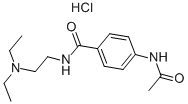Description:
Acecainide, also known as N-acetylprocainamide and ASL 601, is a class III antiarrhythmic compound. It increases the duration of the action potential by decreasing the delayed outward potassium current, slightly decreasing the calcium current, and slightly depressing the inward rectifier potassium current. Acecainide can be given either intravenously or orally, and is eliminated primarily by renal excretion.
- Molecular Weight: 313.82
- Molecular Formula: C15H24ClN3O2
Canonical SMILES:
CC(NC1=CC=C(C(NCCN(CC)CC)=O)C=C1)=O.[H]Cl
InChI:
1S/C15H23N3O2.ClH/c1-4-18(5-2)11-10-16-15(20)13-6-8-14(9-7-13)17-12(3)19;/h6-9H,4-5,10-11H2,1-3H3,(H,16,20)(H,17,19);1H
InChIKey: IYEWBJUCJHKLHD-UHFFFAOYSA-N- Melting Point: 190-193 °C
- Appearance: Light yellow solid powder
- Storage: Store in a cool and dry place (or refer to the Certificate of Analysis).
Synonyms:
4'-((2-(Diethylamino)ethyl)carbamoyl)acetanilide monohydrochloride; Acecainide; N-acetylprocainamide, ASL 601; ASL-601; ASL601.
More details are to be found on supplier website
